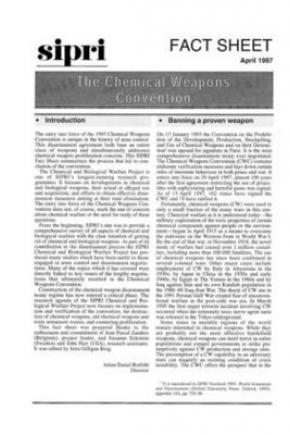The Chemical Weapons Convention
The entry into force of the 1993 Chemical Weapons Convention is unique in the history of arms control. This disarmament agreement both bans an entire class of weapons and simultaneously addresses chemical weapon proliferation concerns. This SIPRI Fact Sheet summarizes the process that led to conclusion of the convention.
The Chemical and Biological Warfare Project is one of SIPRI's longest-running research programmes. It focuses on developments in chemical and biological weapons, their actual or alleged use and acquisition, and efforts to obtain effective disarmament measures aiming at their total elimination. The entry into force of the Chemical Weapons Convention does not, of course, mark the end of concern about chemical warfare or the need for study of these questions.
From the beginning, SIPRI's aim was to provide a comprehensive survey of all aspects of chemical and biological warfare with the clear intentionof getting rid of chemical and biological weapons. As part of its contribution to the disarmament process the SIPRI Chemical and Biological Warfare Project has produced many studies which have been useful to those engaged in arms control and disarmament negotiations. Many of the topics which it has covered were directly linked to key issues of the lengthy negotiations that ultimately resulted in the Chemical Weapons Convention.
Construction of the chemical weapon disarmament treaty regime has now entereda critical phase. The research agenda of the SIPRI Chemical and Biological Warfare Project now focuses on implementation and verification of the convention, the destruction of chemical weapons, old chemical weapons and toxic armament wastes, and countering proliferation.
- Introduction
- Banning a proven weapon
- Chemical disarmament: a historical overview
- Negotiating the CWC
- Objectives of the CWC
- Institutional aspects of the CWC
- The Conference of States Parties
- The Executive Council
- The Technical Secretariat
- The National Authority
- Destruction of the Russian and US chemical weapon stockpiles
- Russia
- The United States
- Chemical weapon proliferation concerns
- Conclusions


